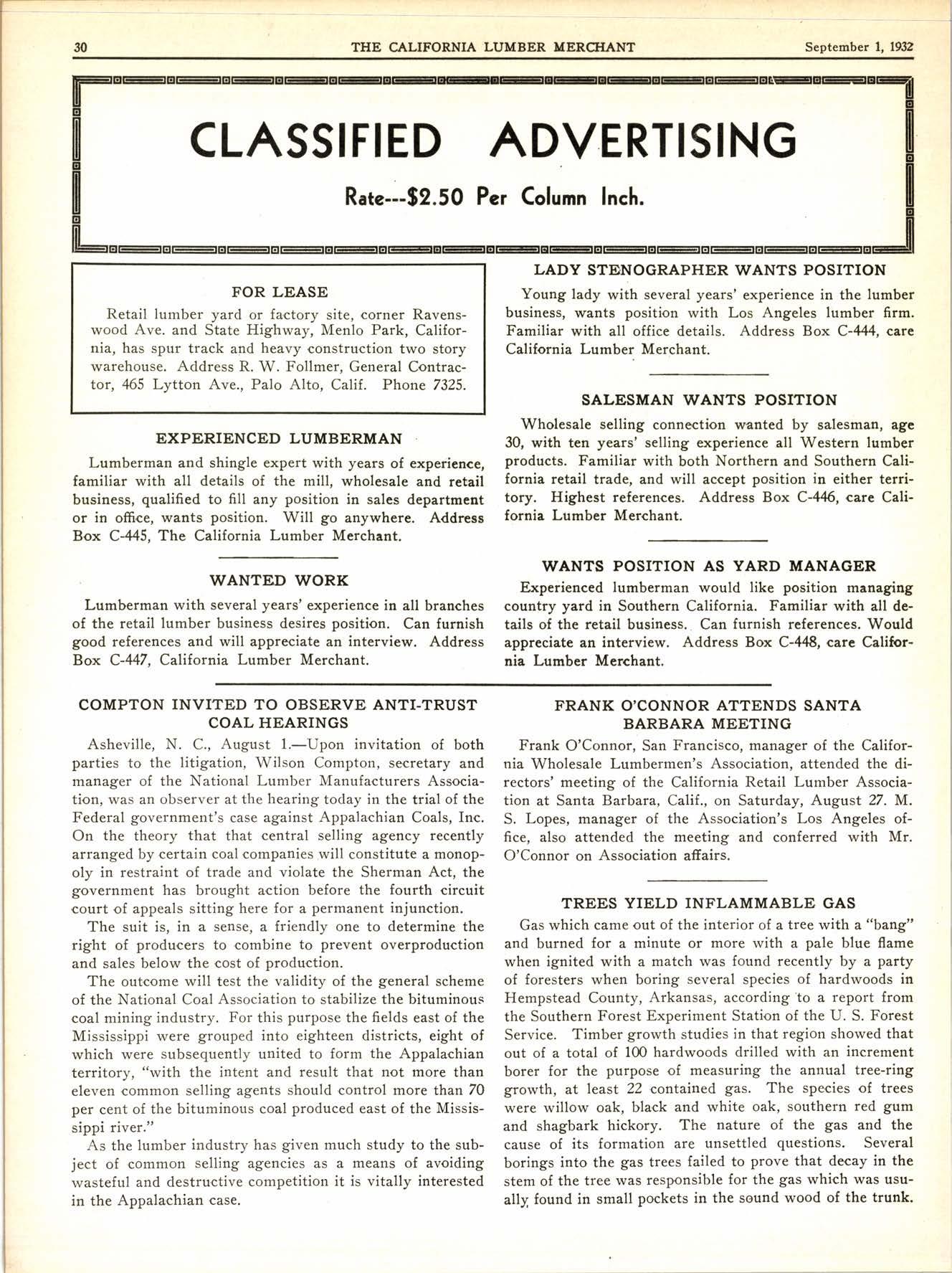
3 minute read
Reduction in Lumber Stocks Need ed, Survey Committee Finds
Washington, August l5.-Notwithstanding a drop in prices of over forty per cent and a decrease of two-thirds in demand since 1929, the lurnber industry is slowly but surely putting its house in order but needs primarily to continue drastic policies of restraint practiced in by most units of the industry during the past year and a half, according to the lates! quarterly report to the U. S. Timber Conservation Board by its special Lumber Survey Committee.
fn accordance with previous recommendations of the Committee, surplus stocks have been reduced more than four billion feet since the peak in the latter part of 1930, it is pointed out. This would have been adequate to balance demand and supply under more favorable circumstances, but the continued drop in demand from an annual requirement of 35.5 billion feet in 1929 to an indicated annual rate of 12.4 billion in the first six months of 1932 indicates need for further reductions in surplus stocks.
The Committee recommends reductions to the extent of 3/a billion feet. As one means to this end it urges avoiding unnecessary production of items already in surplus and the pooling and exchange of stocks and consolidation of sales. It further recommends, as an emergency measure, devising of regional plans for common management of principal operating properties, not to the exclusion, however, of wisely planned regional consolidation, where practicable, of timber ownerships and operations as previously recommended by the Committee. The Committee also suggests the possibility of securing needed credit, in connection with plans for control of production and distribution, through the Reconstruction Finance Corporation.
Present price levels threaten industry solvency and the soundness of individual concerns unless a continued policy of restraint is followed, the Committee reports, in urging banks to avoid forcing lumber company patrons to liquidate on an indifferent market. In this connection the report says:
"The financial soundness and, to a substantial extent, the ultimate solvency generally of the individual lumber companies largefy depend upon tlg effectiveness of present efforts at industry.stabilization and folthe restoration of lumber consumption. The banks should, we believe, refrain, from encouraging or facilitating additional or new production of lumber for which there is no market; and in general should avoid forcing the liquidation of lumber stocks with the resulting inevitable impairment of capital assets. The stability and financial security of the industry and of individual manufacturer will be substantially aided by reasonable encouragement on the part of the banks to their lumber company patrons to follow the course of action, with respect to production and stocks, recommended bv the Timber Conservation Board."
The Committee reiterates the warning contained in the recent report of the U. S. Timber Conservation Board against the present uneconomic method of taxing standing timber as a land improvement and thus forcing its liquida- tion. Suggesting the preferable substitution of .,an equitable system of income or yield taxation for the present prevailing system of property taxation," it says:
"This fact should be directed to the attention of state authorities in confirmation of the imperative need of concerted action, in the principal timber states, to secure such modification of systems of timber taxation as will efiectively avoid the pressure to premature liquidation of standing timber."
It is further recommended that the survey activities of the committee in the interest of economic stabilization of the industry be continued. The Lumber Survey Committee rvas appointed by the Timber Conservation Board on July 9, 1931, and consists of Thomas S. Holden, economist, F. W. Dodge Company, New York; Dr. Frank M. Surface, Assistant Director, Bureau of Foreign and Domestic Commerce; M. W. Star, lumber and coal economist, Columbus, Ohio; Calvin Fentress, President, Baker, Fentress & Company, Chicago; and Wilson Compton, secretary and manager, National Lumber Manufacturers Association. The committee serves voluntarily in cooperation with the work of the Board in its study of the economic situation in the forest products industries and makes its reports to Secretary of Commerce Lamont, as Chairman of the U. S. Timber Conservation Board.
Recreational Use of National Forests Grows
Recreational visitors to the 150 national forests in the United States during 1931 totaled 8,073,917 actual users of the forests and 24,154,696 transient travelers, a grand total of. 32,228,613 people, according to report just issued by the U. S. Forest Service. Of this total number, D,836,412 or 92 per,cent were motorists.
California's national forests lead all States in recreational use with a grand total of 17,454,748 visitors, of which 3,992,64O were actual users and 13,62,18 transient motorists. The San Bernardino and Angeles National Forests in southern California were the most popular mountain playgrounds, with 1,684,000 and, 1,125,@4 forest users, respectively. The most popular northern California forests were the Tahoe, 155,400 visitors; Sequoia, 133,950; and Eldorado, lI2,7S0 visitors.










